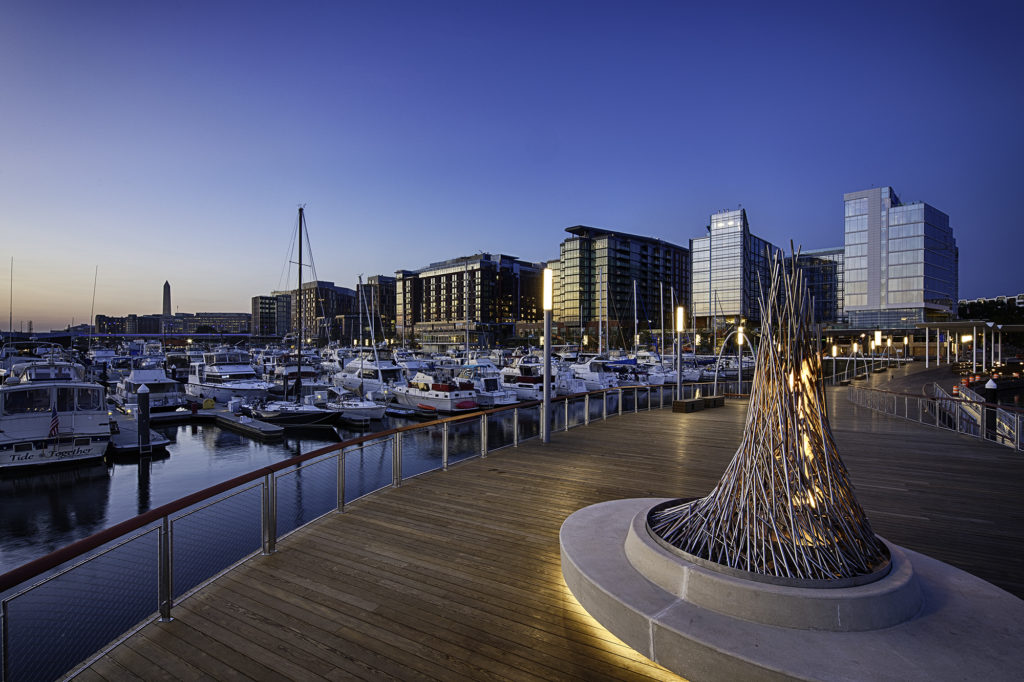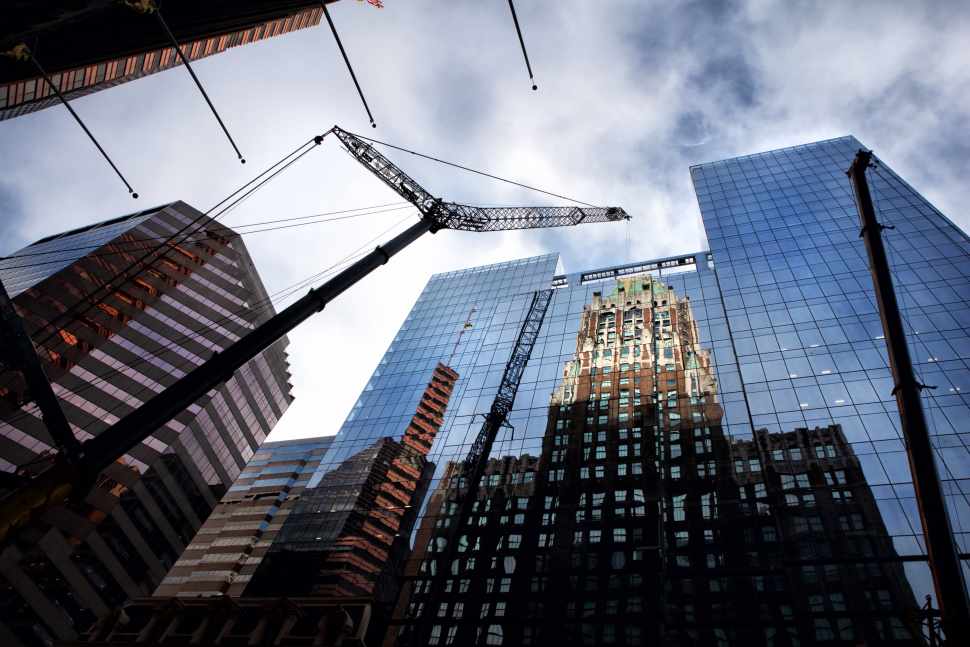
The Wharf is a mixed-use development on Washington, D.C.’s waterfront. At 27 acres and 2.7 million square feet of space, Marquette’s project is one of the largest in the city. (Image courtesy of Matthew Borkoski)
The past year has been unusually consequential for Madison Marquette, even for a company that is accustomed to carrying out bold moves and high-profile projects. In June, the longtime retail and mixed-use developer completed its acquisition of PMRG, the diversified Houston-based firm. The step brings together Madison Marquette’s investment and development expertise with PMRG’s complementary track record in investment management, development and property management. That watershed move follows another headline-making occasion: last year’s successful debut of The Wharf, its signature 3.2 million-square-foot waterfront project in Washington, D.C.
At the center of this flurry of activity is Amer Hammour, who founded Madison Marquette a quarter century ago. As the firm’s chairman, he directs the organization’s investment strategy and leads its growth and capital relationships. He oversees real estate investment and operations for Capital Guidance, a diversified global investment firm and Madison Marquette’s parent company. Over the past 35 years, Hammour has completed investments valued at more than $7 billion on behalf of Capital Guidance and its subsidiaries. In a wide-ranging conversation with CPE, Hammour shed light on what’s ahead for Madison Marquette strategy for the next few years and offered insights into a rapidly changing industry.
What are Madison Marquette’s goals for the rest of 2018 and for 2019?
Hammour: Madison Marquette has just doubled in size by merging with PMRG. One of the most important goals for us is to make sure that we get the best benefit out of it—to manage the integration of the two companies in the best way possible and to make sure we bring the different capabilities to bear on the now-combined company. We also continue to look at several investments with many of our investor partners and are hoping to continue to build our portfolio of properties under management with those investors.
We have a pipeline of deals we’re looking at. My focus over the next few months is on our existing portfolio. I’m spending the end of 2018 by visiting every one of our properties with our project teams to set the business plans for the next two or three years and to give them senior direction on those properties.
The merger with PMRG brings you tremendous synergies, both geographically and by sector. How will the merger affect your operations?
Hammour: We’ve always believed in an integrated model, where the best way we create value on properties is by being able to have people on site who are able to improve them, manage them better, lease them better, give them direction and be the owner at the same time. At Madison Marquette, before we brought in the PMRG team, we were already handling all kinds of mixed-use projects, but PMRG brings more capabilities, particularly in the office area and the development of residential properties. They also have medical offices that we are very excited about because it’s a new area and allows us to expand, but it also allows us to integrate medical uses into our mixed-use properties. I believe that’s part of the future.
We’ve all seen the headlines about the dire outlook for malls. What’s your take on the retail sector?
Hammour: It depends on how you look at it. From a sales point of view, retail sales have been pretty strong. But what we need to recognize is that retailers’ businesses have been completely shaken. Some have been able to adapt, and some are struggling. Some have changed to make it more about the experience. Others, like Best Buy, are providing value-added services. I think at the end of the day, good locations are going to do very well, and destinations anchored with community uses like grocery stores and restaurants are actually increasing their sales and activity. I personally feel that we are at a time of turmoil in retail because of technology, but what’s going to come out of it is, at least in many locations, a different retailing that’s much more about the experience and showcasing and selling products.
Right now, the commercial real estate industry is facing rising interest rates, escalating construction costs and the impact of tariffs. What is the industry’s biggest challenge?
Hammour: This is not an easy time. Construction costs have gone up 30 percent in the last three to four years. The interest rates going up don’t help from a financing point of view. There’s a retail challenge. A different challenge is understanding how technology is affecting the uses and how the uses are changing. We’ve all heard about the creative office, but you could probably ask five office investors what a creative office is, and you get five different answers.
We see the same happening in apartments, which are becoming smaller but with more amenities than a resort hotel. It’s really challenging, as we look at what you need to do to be competitive. This is just the beginning of how people’s lifestyles are changing and how it’s affecting the uses pretty much across the board. People keep talking about retail becoming experiential, but everything is becoming experiential.

Madison Marquette’s One Light Street is a 28-story mixed-use tower in Baltimore with 280 luxury apartments, Class A office space and 5,000 square feet of ground-floor retail space. Image courtesy of MidAtlantic Photographic LLC
Speaking of technology, is technology playing a bigger role in your real estate operations these days?
Hammour: I’ve seen a lot of tech used in shopping centers where you sign up and get informed of new openings and events. For apartment buildings and offices, you have the applications that allow people to get services from their landlords. I just had a conversation about how technology can give us a better understanding of what we should invest in—what kind of returns to expect.
Can technology help us research and underwrite properties? We really haven’t focused on that, but it’s been a major question on my mind. We use technology a lot for our client interface, but can we use it more for our investment work, for our development work, to manage our facilities more efficiently? There’s a lot more to do, and I don’t think the real estate business has been changed enough by technology.
How are you preparing for the end of the real estate cycle?
Hammour: Personally, I think there is another year or two left in the cycle. We’ve looked at the assets we own and we prepared for sale those assets that we think have reached the highest valuation. For the assets that are in the development cycle, we’ve started pushing for completion while we are still in good times. A year ago, we completed the development of the first phase of The Wharf. We have just finished a building in downtown Baltimore, One Light Street.
For the ones that will take longer, we are considering either selling them or putting them on hold. We’ve also become more aggressive in leasing up properties because we don’t want to be caught with too much vacancy at the bottom of the cycle. From an acquisition/investment point of view, we’ve been a net seller, and we’ve been redeploying our money into our existing projects, which either needed to be repositioned or developed. For example, we took a piece of land that we owned in Baltimore for a long time, and we built a $200 million office, residential and parking tower, One Light Street. We financed it, of course, but we put substantial equity in it.
Where do you see the biggest opportunities in the market now?
Hammour: Within each of the major cities we’re in—we’re in 12 markets today—there are some districts that have emerged, and we are looking at acquiring properties within these emerging districts. We’ve done a lot of research on those districts, either to create an anchor to help create that district and help it emerge faster—like we’ve done on La Brea Avenue in Los Angeles, where we bought a whole block of buildings and completely redeveloped it—or to acquire an existing property that’s not fully leased and lease it up. Those are limited downside, but great upside investments. We’re not acquiring a lot of properties in prime areas. We’re helping to create the next district—Long Island City, the Bronx, the southwest waterfront in Washington, D.C.—these are the areas we are looking at and investing in.
